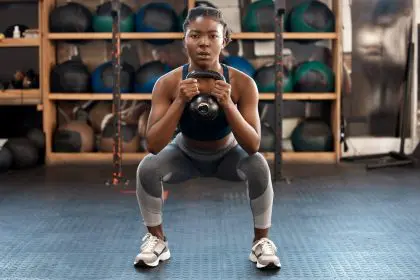Kettlebells have skyrocketed in popularity among fitness enthusiasts seeking efficient, effective workouts. This uniquely shaped weight—resembling a cannonball with a handle—dates back to 18th century Russia but has found new life in modern fitness routines for good reason.
The distinctive design of kettlebells creates an offset center of gravity, requiring additional stabilization from your core and other muscle groups during every movement. This increased muscle recruitment translates to more calories burned in less time compared to traditional dumbbells or barbells.
Another significant advantage comes from the versatility kettlebells offer. A single kettlebell allows you to perform exercises that simultaneously develop cardiovascular endurance, muscular strength, and flexibility—a true all-in-one workout tool that eliminates the need for multiple pieces of equipment.
Kettlebells come in various weights typically ranging from 5 to 100 pounds, making them accessible for beginners while still challenging for advanced athletes. Most women typically start with 8-16 pound kettlebells, while men often begin with 16-24 pound options, progressing to heavier weights as strength improves.
For those new to kettlebell training, mastering proper form remains essential before increasing weight or intensity. The dynamic nature of many kettlebell exercises means proper technique protects joints and prevents injury while maximizing results.
The kettlebell swing: foundation move for maximum calorie burn
The kettlebell swing stands as the signature movement in kettlebell training, delivering exceptional calorie-burning potential while strengthening multiple muscle groups simultaneously. This power-generating exercise primarily targets the posterior chain—the hamstrings, glutes, and lower back—while engaging the core, shoulders, and arms as stabilizers.
Begin by standing with feet hip-width apart, holding a kettlebell with both hands at your centerline. Slightly bend your knees while shifting your hips backward, bringing your torso nearly parallel with the floor. To return to standing, forcefully engage your glutes and drive your hips forward, creating momentum that swings the kettlebell forward and up. Maintain core engagement throughout the entire set and avoid rounding your back. Perform 15 repetitions at a quick pace to maximize the cardiovascular benefit.
The effectiveness of the kettlebell swing comes from its explosive hip hinge pattern, which mimics athletic movements used in sports while elevating heart rate quickly. A 155-pound person can burn approximately 20 calories per minute during high-intensity kettlebell swings—making it one of the most efficient calorie-burning exercises available.
For beginners, mastering the hip hinge motion without weight helps establish proper form before adding the kettlebell. Focus on driving the movement with your hips rather than pulling with your arms for maximum effectiveness and safety.
The suitcase carry walk: core stabilization in motion
The kettlebell suitcase carry walk may look deceptively simple but delivers remarkable benefits for core strength, posture improvement, and functional fitness that transfers to daily activities like carrying groceries or luggage.
Grasp the kettlebell firmly in one hand and stand at one end of your exercise space. Draw your shoulders down and back, lift your chest, and engage your core muscles. Maintaining this muscle engagement, walk forward while holding the kettlebell in one hand. Continue walking for 20 steps, then switch hands and repeat in the opposite direction. For optimal results, maintain proper posture and avoid taking excessively wide strides. Complete one set of 20 steps in each direction.
The magic of this exercise lies in the offset load, which forces your core muscles—particularly the obliques—to work overtime preventing the torso from leaning toward the weighted side. This anti-lateral flexion training strengthens crucial stabilizing muscles often missed in traditional core workouts.
The suitcase carry also improves grip strength, shoulder stability, and activates the often-neglected gluteus medius muscle responsible for hip stability. Together, these benefits translate to improved performance in other exercises and reduced injury risk during daily activities.
For added challenge, try maintaining a slow, controlled pace with each step or increase the weight gradually as your stability improves. The key lies in maintaining perfectly upright posture throughout the movement—if you begin leaning, the weight is too heavy.
Kettlebell squats: lower body power with added intensity
The kettlebell squat transforms the traditional bodyweight squat into a more challenging, calorie-intensive exercise that builds lower body strength while improving core stability and cardiovascular endurance when performed with proper pacing.
Stand with feet hip-width apart, holding the kettlebell with both hands at chest height, elbows pointed down. Keep your chest lifted while bending your knees and shifting your hips backward. Lower your buttocks into a squat until your thighs become parallel to the ground. Press your heels firmly into the floor and engage your glutes to return to standing position. Ensure your knees track in line with your toes without extending past them. Complete 10 repetitions at a controlled pace.
The goblet position of the kettlebell creates a counterbalance that helps maintain proper form while adding resistance to the movement. This position also engages the core more intensely than a bodyweight squat, increasing the overall calorie burn and functional benefit.
For those seeking additional challenge, consider adding a pulse at the bottom of the movement or performing a slower eccentric (lowering) phase. Both variations increase time under tension for the muscles, enhancing strength development and metabolic effect.
Beginners should focus first on achieving proper depth and alignment before increasing weight. The ability to maintain a neutral spine and proper knee position throughout the movement indicates readiness for progression to heavier kettlebells.
Kettlebell shoulder press: upper body strength with core stability
The kettlebell shoulder press builds impressive upper body strength while requiring significant core stabilization, making it more metabolically demanding than traditional dumbbell presses and more functional for everyday pushing movements.
Stand with feet hip-width apart, holding the kettlebell by the handles at chest height. Maintain a slight bend in your knees for stability as you press the weight directly overhead. Fully extend your arm(s) without locking the elbow joint. Slowly lower the kettlebell back down to chest level with control. Keep your shoulders pulled down away from your ears and avoid arching your back. Complete 10 controlled repetitions.
The offset center of mass in the kettlebell creates an additional stability challenge for the shoulder joint, engaging more supporting muscles than traditional weights. This recruitment of additional muscle fibers increases calorie expenditure while building functional strength applicable to real-world lifting and reaching movements.
For beginners, starting with a lighter kettlebell allows proper technique development before progressing. The shoulder press can be performed with one arm at a time for increased core engagement or with both arms simultaneously for efficiency.
To maximize benefits, focus on maintaining full-body tension throughout the movement—engage your core, squeeze your glutes, and create a solid foundation through your feet. This total-body approach transforms the shoulder press from an isolated exercise into a comprehensive strength developer.
Single-leg deadlift: balance, strength and posterior chain power
The kettlebell single-leg deadlift stands out as one of the most effective exercises for simultaneously developing balance, hamstring flexibility, glute strength, and core stability—all while burning significant calories due to the large muscle groups involved.
Hold a kettlebell in one hand while shifting your weight onto the opposite foot. Slightly bend the supporting knee while hinging forward at your hips. Keeping your glutes and core engaged, extend the non-supporting leg behind you. Lower your torso until it becomes parallel with the floor, with the kettlebell hanging directly beneath your shoulder. Press your grounded foot firmly into the floor as you return to standing position. Maintain a flat back throughout the movement for proper form. Complete 10 repetitions per side.
This exercise effectively trains the posterior chain—the powerful hamstrings, glutes, and lower back muscles—while simultaneously challenging your balance and proprioception. The unilateral nature of the movement helps identify and correct strength imbalances between sides of the body.
For those new to the exercise, beginning with a light kettlebell or even bodyweight allows for proper movement pattern development. Placing the free hand lightly on a wall or sturdy object can help maintain balance until stability improves.
Advanced practitioners can increase difficulty by slowing the movement, particularly the lowering phase, or by adding a row at the bottom position. These variations increase time under tension and muscle recruitment, further enhancing the calorie-burning effect.
Single-hand bent-over row: back strength with rotational stability
The kettlebell single-hand bent-over row targets the often-neglected back muscles while challenging the core’s ability to resist rotation—a key component of functional fitness and injury prevention that traditional machine rows miss entirely.
Stand with feet hip-width apart, holding the kettlebell in your left hand. Bend your knees slightly and hinge forward at your hips. Maintain a completely straight back position throughout the exercise. Row the kettlebell up to shoulder height by bending your elbow straight up toward the ceiling. Keep the weight close to your side and your core tight during the entire set. Lower the weight with control to the starting position. Complete 10 repetitions per side.
The unilateral nature of this exercise creates rotational forces that your core must resist, activating the obliques and transverse abdominis more intensely than bilateral rowing movements. This additional muscle recruitment increases caloric expenditure while building functional strength.
The bent-over row particularly targets the latissimus dorsi, rhomboids, and posterior deltoids—muscles essential for good posture and upper body function that often weaken with sedentary lifestyles. Strengthening these muscles helps counteract the forward-hunched position many develop from desk work.
Beginners should focus on maintaining a neutral spine position throughout the movement, avoiding the temptation to twist or rotate the torso as the weight moves. As with all kettlebell exercises, mastering form with lighter weights before progressing ensures safety and maximizes results.
Creating your calorie-torching kettlebell routine
Combining these six powerful kettlebell exercises creates a comprehensive workout that builds strength, enhances flexibility, and burns calories efficiently. For maximum effect, structure your routine in a circuit format that minimizes rest between exercises.
A beginner-friendly approach involves performing one set of each exercise in sequence with minimal rest between movements, then resting 60-90 seconds before repeating the circuit 2-3 times total. This format maintains elevated heart rate throughout the workout, maximizing caloric expenditure in minimal time.
As fitness improves, increase the challenge by adding a second or third set of each exercise before moving to the next movement, or by decreasing rest periods between sets. These progressions further intensify the metabolic demand without necessarily requiring heavier weights.
For optimal results, perform this kettlebell circuit 2-3 times weekly with at least one day of recovery between sessions. Complement these workouts with cardiovascular activities like walking, cycling, or swimming on alternate days for a well-rounded fitness program.
Those new to kettlebell training should consider working with a qualified fitness professional for initial instruction. Proper form remains essential not only for safety but also for maximizing the effectiveness of each movement.
The beauty of kettlebell training lies in its scalability and efficiency. With just one piece of equipment and these six fundamental movements, you can create a challenging workout that delivers comprehensive fitness benefits in half the time of traditional training methods. Whether your goal involves weight management, strength development, or improved functional fitness, kettlebells provide an effective solution that grows with your abilities.


















